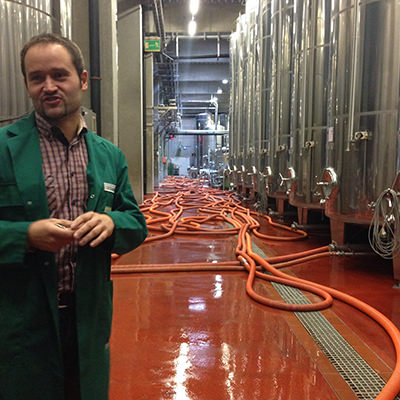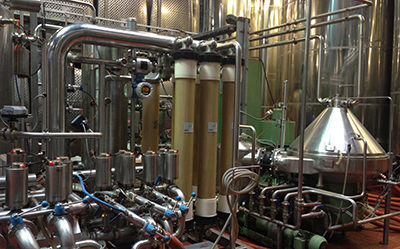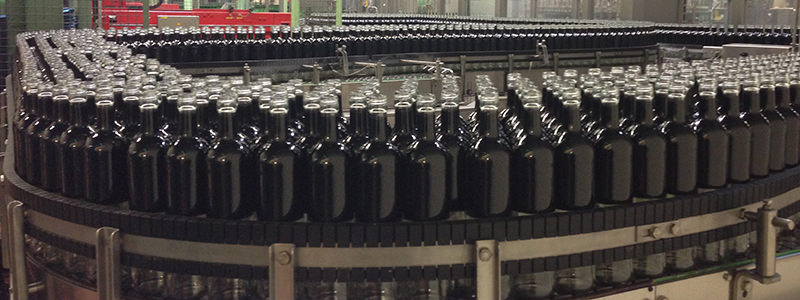The first sign that something was different was the securitized door. I’ve been to a lot of wineries, and none of them have security guards and doors requiring a key to open.
Next, the lab coats: they were bright green, and long, with buttons and pockets. These coats were required apparel for entering the winery, which would in fact be better named a wine factory. What else do you call a building that produces 50 million bottles each year? Many of which, actually, are boxes–”bottles” is just a unit of measurement.

I was once a regular drinker of three-buck-chuck (which, back then, cost two bucks). These were my student days and I could barely afford to pay my rent in New York, so I compensated for it by eating mostly falafel and pizza, and hesitated deeply before taking a $6-bottle of Merlot to the checkout line at Trader Joe’s.
Which is to say, I understand the need for cheap, mass-produced wine, and I get why many people prefer to keep on drinking it. After all, when you start educating your palate, you are potentially developing a preference for more sophisticated–and expensive–wine. And we all have enough daily expenses already. That said, I personally think life is too short to drink bad, cheap wine, and I am going to do my damnedest to convince you to spend more money on bottles, and try new things.
Being in the wine factory reaffirmed my belief that bulk is definitely not better. After buttoning on our green lab coats, we – a group of U.S. journalists, touring the Rheingau and Rheinhessen – entered the factory through the entrance where the fruit arrives.
All wine starts this way – with freshly-picked fruit. The difference here, though, is that the fruit does not come from vineyards beside the winery, or even a short drive away. Fruit comes to the wine factory from all over Europe, and in some cases, already pressed juice even traveled from California, to be bottled or packaged in boxes, and shipped around the Continent. About 20,000 different producers within Germany alone deliver fruit to this wine factory.

Within the winery were the enormous stainless steel tanks, which is where the juice begins to ferment with the addition of industrial yeasts. Moving forward, we saw a series of filtration devices. This is where the fermented juice gets cleaned, so that no bacteria, sediment, or yeasts are leftover. In small-scale wineries, this might not happen at all – which results in a wine full of bacteria, still living, and juice that tastes fresh and full of yeasty fermentation flavor. But that’s not ideal for wine produced at this scale – it has to be fully cleaned.
After the filtration area, we saw a clock, ticking off each case that was finished with production, making sure the factory would meet its bottle quota for the day. 50 million bottles each year would mean about 137,000 bottles per day! To give you a sense of scale, some European winemakers make around 60,000 bottles per year – which is on the smaller side, but still enough to export.
It was in the bottling room, where we watched rows of empty bottles get filled, labeled, corked, and packed into boxes, that it really hit home: cheap wine is truly a miracle of the assembly line. For the millions of bottles being produced each month, there were no more than two employees working in the bottling room. We hardly saw other workers throughout the winery, either. The lack of human labor really struck me.
This kind of wine is as anonymous as it gets. There is no essence of terroir in these bottles or boxes, nor is there any hallmark of a winemaker, his style, or a regional style.
Of course, the winemaker and sales manager told us over and over that they are proud of the level of quality of their wines. And the ultimate question, I’m sure you’re wondering: do these wines taste good? Compared to most of the wine I drink, no, they tasted terrible. They were like drinking Kool-Aid or Tang, instead of freshly-squeezed orange juice. These wines tasted dead to me – the flavors were so artificial and manufactured. And nothing about them reflected Germany’s land or culture – even though we were right in the heart of Germany’s best vineyards.
If you are really not interested in terroir, or how wine can reveal cultural history, then that’s fine – you should only drink cheap wine, produced in these kinds of factories. But once you start drinking wine made with integrity and at smaller-scales–by people who are passionate about what they’re doing, and the land they are working to grow grapes–you will notice the difference. And you might even have some kind of an experience where a wine actually moves you, and makes you feel something you can’t quite put words to. That’s what a truly great wine can accomplish.
All photos by Rachel Signer

